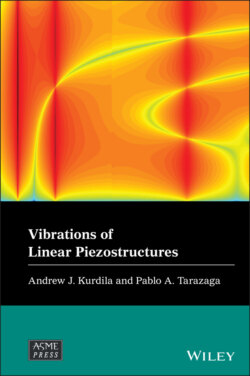Читать книгу Vibrations of Linear Piezostructures - Andrew J. Kurdila - Страница 11
Preface
ОглавлениеThe goal of this book is to provide a self‐contained, comprehensive, and introductory account of the modern theory of vibrations of linearly piezoelectric structural systems. While the piezoelectric effect was first investigated by the Curies in the , and systematically investigated in the field of acoustics and the development of sonar during the First World War, it is only much more recently that we have seen the widespread interest in mechatronic systems that feature piezoelectric sensors and actuators. Many of the early, now classical, texts present piezoelectricity from the viewpoint of a material scientist such as in [22] or [53]. Others are difficult, if not impossible, to obtain since they are out of print. Older editions of the excellent text [20] are currently selling for prices in excess of $600 on sites such as Amazon.com. Moreover, it is also quite difficult to find treatments of piezoelectricity that systematically cover all the relevant background material from first principles in continuum mechanics, continuum electrodynamics, or variational calculus that are necessary for a comprehensive introduction to vibrations of piezoelectric structures. The authors know of no text that assimilates all this requisite supporting material into one source. One text may give an excellent overview of piezoelectric constitutive laws, but neglect to discuss variational methods. Another may cover variational methods for piezoelectric systems, but fail to review the first principles of electrodynamics, and so forth. A large, substantive literature on various aspects of piezoelectricity has evolved over the past few years in archival journal articles, but much of this material has never been systematically represented in a single text.
This book has evolved from the course notes that the authors have generated while offering courses in active materials, smart systems, and piezoelectric materials over the past decade at various research universities. Most recently, the authors have taught active materials and smart structures courses that feature piezoelectricity at Virginia Tech to a diverse collection of first year graduate students. So much time was dedicated to the particular systems that include piezoelectric components that this textbook emerged. The backgrounds of the students in our classes have varied dramatically. Many students have not had a graduate class in vibrations, continuum mechanics, advanced strength of materials, nor electrodynamics. For this reason, the notes that evolved into this book make every effort to be self‐contained. Admittedly, this text covers in one chapter what other courses may cover over one or two semesters of dedicated study. As an example, Chapter 3 reviews the fundamentals of continuum mechanics for this text, a topic that is covered in other graduate classes at an introductory level during a full semester. So, while the presentation attempts to be comprehensive, the pace is sometimes brisk.
While preparing this text, we have tried to structure the material so that it is presented at the senior undergraduate or first year graduate student level. It is intended that this text provide the student with a good introduction to the topic, one that will serve them well when they seek to pursue more advanced topics in other texts or in their research. For example, this text can serve as a introduction to the fundamentals of modeling piezoelectric systems, and it can prepare the student specializing in energy harvesting when they consult a more advanced text such as [21].
This text begins in Chapter 2 with a review of the essential mathematical tools that are used frequently throughout the book. Topics covered include frames, coordinate systems, bases, vectors, tensors, introductory crystallography, and symmetry. Chapter 3 then gives a fundamental summary of topics from continuum mechanics. The stress vector and tensor is defined, Cauchy's Principle and the equilibrium equations are derived. The strain tensor is defined, and an introduction to constitutive laws for linearly elastic materials is also covered in this chapter. Chapter 4 provides the student the required introduction to continuum electrodynamics that is essential in building the theory of linear piezoelectricity in subsequent chapters. The definitions of charge, current, electric field, electric displacement, and magnetic field are introduced, and then Maxwell's equations of electromagnetism are studied.
Linear piezoelectricity is covered in Chapter 5. The discussion begins by introducing a physical example of the piezoelectric effect in one spatial example, and subsequently giving a generalization of the phenomenon in terms of piezoelectric constitutive laws. The initial‐boundary value problem of linear piezoelectricity is then derived from the analysis of Maxwell's equations and principles of continuum mechanics. While the equations governing any particular piezoelectric structure can be derived in principle from the initial‐boundary value problem of linear piezoelectricity, it is often possible and convenient to derive them directly for a problem at hand. Chapter 6 discusses the application of Newton's equations of motion for several prototypical piezoelectric composite structural systems. Chapter 7 provides a detailed account of how variational techniques can be used, instead of Newton's method, for many linearly piezoelectric structures. In some cases the variational approach can be much more expedient in deriving the governing equations. This chapter starts with a review of variational methods and Hamilton's Principle for linearly elastic structures. The approach is then extended by formulating Hamilton's Principle for Piezoelectric Systems and Hamilton's Principle for Electromechanical Systems. Several examples are considered, including the piezoelectrically actuated rod and Bernoulli–Euler beam, as well as the electromechanical systems that result when these structures are connected to ideal passive electrical networks. The book finishes in Chapter 8 with a discussion of approximation methods. Both modal approximations and finite element methods are discussed. Numerous example simulations are described in the final chapter, both for the actuator equation alone and for systems that couple the actuator and sensor equations.
June, 2017
Andrew J. Kurdila
Pablo A. Tarazaga
